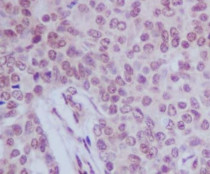ARG41990
anti-ATF5 antibody
anti-ATF5 antibody for ICC/IF,IHC-Formalin-fixed paraffin-embedded sections,Immunoprecipitation,Western blot and Human,Mouse,Rat
Overview
| Product Description | Rabbit Polyclonal antibody recognizes ATF5 |
|---|---|
| Tested Reactivity | Hu, Ms, Rat |
| Tested Application | ICC/IF, IHC-P, IP, WB |
| Host | Rabbit |
| Clonality | Polyclonal |
| Isotype | IgG |
| Target Name | ATF5 |
| Antigen Species | Human |
| Immunogen | Synthetic peptide of Human ATF5. |
| Conjugation | Un-conjugated |
| Alternate Names | HMFN0395; cAMP-dependent transcription factor ATF-5; Cyclic AMP-dependent transcription factor ATF-5; Activating transcription factor 5; Transcription factor ATFx; ATFX |
Application Instructions
| Application Suggestion |
|
||||||||||
|---|---|---|---|---|---|---|---|---|---|---|---|
| Application Note | * The dilutions indicate recommended starting dilutions and the optimal dilutions or concentrations should be determined by the scientist. | ||||||||||
| Positive Control | Jurkat | ||||||||||
| Observed Size | ~ 32 kDa |
Properties
| Form | Liquid |
|---|---|
| Purification | Affinity purified. |
| Buffer | PBS (pH 7.4), 150 mM NaCl, 0.02% Sodium azide and 50% Glycerol. |
| Preservative | 0.02% Sodium azide |
| Stabilizer | 50% Glycerol |
| Storage Instruction | For continuous use, store undiluted antibody at 2-8°C for up to a week. For long-term storage, aliquot and store at -20°C. Storage in frost free freezers is not recommended. Avoid repeated freeze/thaw cycles. Suggest spin the vial prior to opening. The antibody solution should be gently mixed before use. |
| Note | For laboratory research only, not for drug, diagnostic or other use. |
Bioinformation
| Database Links | |
|---|---|
| Gene Symbol | ATF5 |
| Gene Full Name | activating transcription factor 5 |
| Function | Transcriptional activator which binds the cAMP response element (CRE) (consensus: 5'-GTGACGT[AC][AG]-3'), a sequence present in many viral and cellular promoters and blocks the differentiation of neuroprogenitor cells into neurons. Its transcriptional activity is enhanced by CCND3 and slightly inhibited by CDK4. [UniProt] |
| Cellular Localization | Cytoplasm. Nucleus. Cytoplasm, cytoskeleton, microtubule organizing center, centrosome. Note=Actively transported to the centrosome and accumulated in the pericentriolar material (PCM) during G1 to M phase via a microtubule-dependent mechanism. During late telophase and cytokinesis, translocates from the centrosome to the midbody. [UniProt] |
| Calculated MW | 31 kDa |
| PTM | Ubiquitinated by CDC34 and UBE2B in order to be degraded by the proteasome. Cisplatin inhibits ubiquitination and proteasome-mediated degradation by inhibiting the interaction with CDC34 (PubMed:18458088). Ubiquitination and degradation by the proteasome are inhibited by NLK in a kinase-independent manner (PubMed:25512613). Phosphorylated by NLK, probably at Ser-92, Thr-94, Ser-126 and Ser-190. Acetylated at Lys-29 by EP300, the acetylation enhances the interaction with CEBPB, DNA-binding and transactivation activity. [UniProt] |
Images (2) Click the Picture to Zoom In







